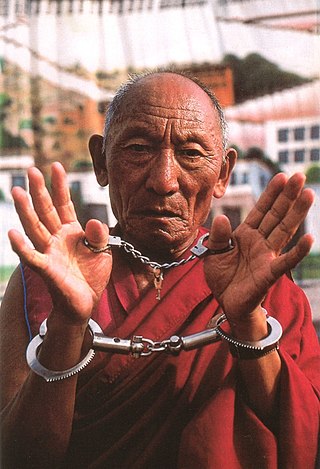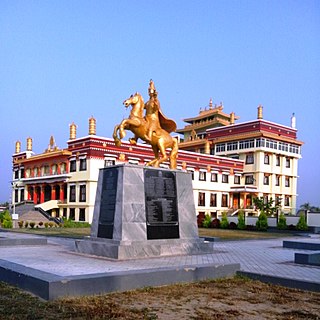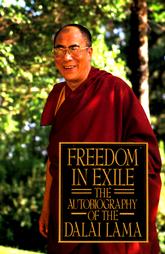
The Central Tibetan Administration is the Tibetan government in exile, based in Dharamshala, India. It is composed of a judiciary branch, a legislative branch, and an executive branch, and offers support and services to the Tibetan exile community.

The Tibetan independence movement is the political movement advocating for the reversal of the 1950 annexation of Tibet by the People's Republic of China, and the separation and independence of Greater Tibet from China.
The Dorje Shugden controversy is a controversy over Dorje Shugden, also known as Dolgyal, whom some consider to be one of several protectors of the Gelug school, the school of Tibetan Buddhism to which the Dalai Lamas belong. Dorje Shugden has become the symbolic focal point of a conflict over the "purity" of the Gelug school and the inclusion of non-Gelug teachings, especially Nyingma ones.

The national flag of Tibet (བོད་ཀྱི་རྒྱལ་དར།), also unofficially known as the Snow Lion Flag, depicts a white snow-covered mountain, a yellow sun with red and blue rays emanating from it, two Tibetan snow lions, a multi-coloured jewel representing Buddhist values, a taijitu and a yellow border around three of its four sides. The flag was used as the national flag of the independent country of Tibet from 1916 until 1951, when Tibet was annexed by the People's Republic of China. It was adopted by the 13th Dalai Lama in 1916 and used in Tibet until the Tibetan uprising of 1959, after which the flag was outlawed in the People's Republic of China. While the Tibetan flag is illegal in Tibet today as it is governed by the PRC as the Tibet Autonomous Region, it continues to be used by the Central Tibetan Administration, the Tibetan government-in-exile based in Dharamshala in India, and by pro-Tibet groups all over the world to show support for human rights in Tibet and Tibetan independence.

Chushi Gangdruk was a Tibetan guerrilla group. Formally organized on 16 June 1958, the Chushi Gangdruk fought the forces of the People's Republic of China (PRC) from 1956 until 1974 when the Central Intelligence Agency (CIA) withdrew its support for the guerrilla group.

Jetsun Pema is the sister of the 14th Dalai Lama. For 42 years she was the President of the Tibetan Children's Villages (TCV) school system for Tibetan refugee students.

The Seventeen-Point Agreement, officially the Agreement of the Central People's Government and the Local Government of Tibet on Measures for the Peaceful Liberation of Tibet, was an agreement between Tibet and the People's Republic of China. It was signed by plenipotentiaries of the Central People's Government and the Tibetan Government on 23 May 1951, in Zhongnanhai, Beijing. The 14th Dalai Lama ratified the agreement in the form of a telegraph on 24 October 1951. The Agreement was legally repudiated by Tibet less than eight years later on 11 March 1959.

The history of Tibet from 1950 to the present includes the Chinese annexation of Tibet, during which Tibetan representatives signed the controversial Seventeen Point Agreement following the Battle of Chamdo and establishing an autonomous administration led by the 14th Dalai Lama under Chinese sovereignty. Subsequent socialist reforms and other unpopular policies of the Chinese Communist Party led to armed uprisings, eventually assisted by the CIA, and their violent suppression. During the 1959 Tibetan uprising, the 14th Dalai Lama escaped to northern India for fear of being captured by Chinese forces. He formed the Central Tibetan Administration and rescinded the Seventeen Point Agreement. In 1965, the majority of Tibet's land mass, including all of U-Tsang and parts of Kham and Amdo, was established as the Tibet Autonomous Region. Tibetans suffered along with the rest of China during the Great Chinese Famine and the Cultural Revolution under episodes of starvation, religious repression, destruction of cultural sites, forced labour, and political persecution. US-China rapprochement in the 1970s saw an end to Washington's support for Tibetan guerillas. Amid broader reforms across the country, China adopted policies to improve conditions in Tibet. Since the 2000s, it has invested heavily in the region but generated controversies due to the sinicization of Tibet. Human rights abuses remain a concern especially where it comes to freedom of religion and political prisoners.

The 1959 Tibetan uprising began on 10 March 1959, when a revolt erupted in Lhasa, the capital of Tibet, which had been under the effective control of the People's Republic of China (PRC) since the Seventeen Point Agreement was reached in 1951. The initial uprising occurred amid general Chinese-Tibetan tensions and a context of confusion, because Tibetan protesters feared that the Chinese government might arrest the 14th Dalai Lama. The protests were also fueled by anti-Chinese sentiment and separatism. At first, the uprising mostly consisted of peaceful protests, but clashes quickly erupted and the Chinese People's Liberation Army (PLA) eventually used force to quell the protests. Some of the protesters had captured arms. The last stages of the uprising included heavy fighting, with high civilian and military losses. The 14th Dalai Lama escaped from Lhasa, while the city was fully retaken by Chinese security forces on 23 March 1959. Thousands of Tibetans were killed during the 1959 uprising, but the exact number of deaths is disputed.

Palden Gyatso was a Tibetan Buddhist monk. Arrested for protesting during the Chinese invasion of Tibet, he spent 33 years in Chinese prisons and labor camps, where he was extensively tortured, and served the longest term of any Tibetan political prisoner. After his release in 1992 he fled to Dharamsala in North India, in exile. He was still a practicing monk and became a political activist, traveling the world publicizing the cause of Tibet up until his death in 2018. His autobiography Fire Under the Snow is also known as The Autobiography of a Tibetan Monk. He was the subject of the 2008 documentary film Fire Under the Snow.

Phüntsok Wangyal Goranangpa, also known as Phüntsog Wangyal, Bapa Phüntsok Wangyal or Phünwang, was a Tibetan politician. A major figure in modern Sino-Tibetan relations, he is best known for being the founder and leader of the Tibetan Communist Party and spending 18 years in the maximum-security prison Qincheng for political prisoners in Beijing in solitary confinement.

The 14th Dalai Lama, Tenzin Gyatso, full spiritual name: Jetsun Jamphel Ngawang Lobsang Yeshe Tenzin Gyatso, also known as Tenzin Gyatso; né Lhamo Thondup; is the incumbent Dalai Lama, the highest spiritual leader and head of Tibetan Buddhism. Before 1959, he served as both the resident spiritual and temporal leader of Tibet, and subsequently established and led the Tibetan government in exile represented by the Central Tibetan Administration in Dharamsala, India. The adherents of Tibetan Buddhism consider the Dalai Lama a living Bodhisattva, specifically an emanation of Avalokiteśvara or Chenrezig, the Bodhisattva of Compassion, a belief central to the Tibetan Buddhist tradition and the institution of the Dalai Lama. The Dalai Lama, whose name means Ocean of Wisdom, is known to Tibetans as Gyalwa Rinpoche, The Precious Jewel-like Buddha-Master, Kundun, The Presence, and Yizhin Norbu, The Wish-Fulfilling Gem. His devotees, as well as much of the Western world, often call him His Holiness the Dalai Lama, the style employed on his website. He is also the leader and a monk of the Gelug school, the newest school of Tibetan Buddhism, formally headed by the Ganden Tripa.

The Tibetan diaspora is the relocation of Tibetan people from Tibet, their country of origin, to other nation states to live as exiles and refugees in communities. The diaspora of Tibetan people began in the early 1950s, peaked after the 1959 Tibetan uprising, and continues.

The CIA Tibetan program was an anti-Chinese government covert operation spanning almost twenty years. It consisted of "political action, propaganda, paramilitary and intelligence operations" facilitated by arrangements made with brothers of the 14th Dalai Lama, who himself was allegedly not initially aware of them. The stated goal of the program was "to keep the political concept of an autonomous Tibet alive within Tibet and among several foreign nations". The program was administrated by the CIA, and unofficially operated in coordination with domestic agencies such as the Department of State and the Department of Defense.

Protests and uprisings against the government of the People's Republic of China have occurred in Tibet since 1950, and include the 1959 uprising, the 2008 uprising, and the subsequent self-immolation protests.

The Battle of Chamdo occurred from 6 to 24 October 1950. It was a military campaign by the People's Republic of China (PRC) to take the Chamdo Region from a de facto independent Tibetan state. The campaign resulted in the capture of Chamdo and the annexation of Tibet by the People's Republic of China.

Gyalo Thondup, born c.1927, is the second-eldest brother of the 14th Dalai Lama. He often acted as the Dalai Lama's unofficial envoy.

Chamdowa Tsawabomei Shangri Lhagyal (1921–1984) was a Tibetan resistance fighter against Chinese occupying forces in 1958–59. He was one of the commanders of the Chushi Gangdruk guerrillas, and fled to India in April 1959 shortly after the arrival there of the 14th Dalai Lama.
In March 1959, the 14th Dalai Lama escaped from China, together with members of his family and his government. They fled the Chinese authorities, who were suspected of wanting to detain him. From Lhasa, the Tibetan capital, the Dalai Lama and his entourage travelled southwards to Tawang in India, where he was welcomed by the Indian authorities.

Lobsang Tashi, also known as Khenchen Lobsang Tashi (1897–1966) was a Tibetan politician who was a senior monastic official and the monastic prime minister (sileun) of the Tibetan government during the early Chinese occupation of Tibet. After the departure of the 14th Dalai Lama in 1959, he was incarcerated in Drapchi Prison where he died in 1966.
















